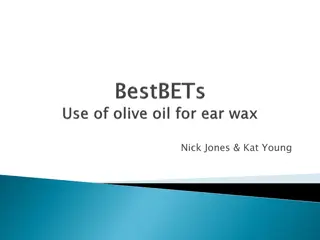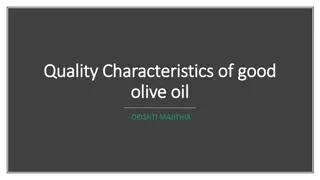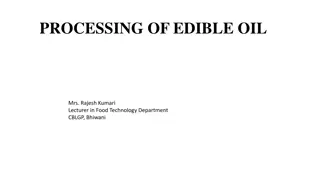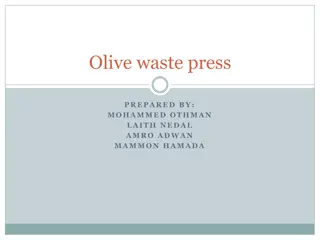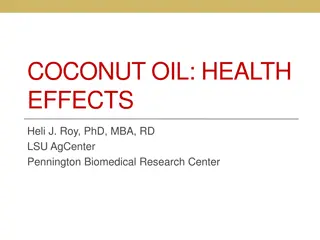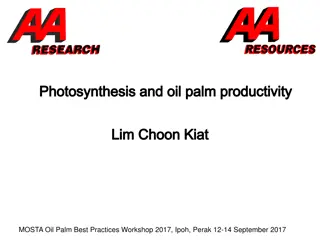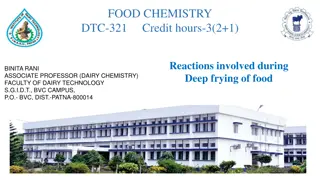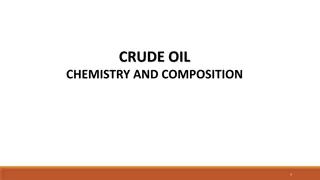Understanding Olive Oil as a Functional Food and its Impact on Health
Olive oil is a functional food believed to benefit health due to its unique production process preserving antioxidants. Classified into virgin, refined, and olive-pomace types, olive oil offers various quality factors and composition primarily consisting of triacylglycerols and oleic acid. Its relation to disease prevention and overall health makes it a valuable addition to the diet.
Download Presentation

Please find below an Image/Link to download the presentation.
The content on the website is provided AS IS for your information and personal use only. It may not be sold, licensed, or shared on other websites without obtaining consent from the author. Download presentation by click this link. If you encounter any issues during the download, it is possible that the publisher has removed the file from their server.
E N D
Presentation Transcript
Olive Oil as A Functional Food Description Types Relation with Disease
Introduction Introduction Olive oil is thought to not only contribute nutrients to the diet, but also to have a positive impact on health. The uniqueness of olive oil lies in the fact that it is not produced by solvent extraction, but rather by a cold-press mechanical process that preserves both the chemical nature of the oil and the natural antioxidants that are produced in response to environmental stress.
CODEX STANDARD FOR OLIVE OILS CODEX STANDARD FOR OLIVE OILS Olive oil is the oil obtained solely from the fruit of the olive tree (Olea europaea L.), to the exclusion of oils obtained using solvents or re- esterification processes and of any mixture with oils of other kinds. Virgin olive oils are the oils obtained from the fruit of the olive tree solely by mechanical or other physical means under conditions, particularly thermal conditions, that do not lead to alterations in the oil, and which have not undergone any treatment other than washing, decanting, centrifuging and filtration. Olive-pomace oil is the oil obtained by treating olive pomace with solvents or other physical treatments, to the exclusion of oils obtained by re- esterification processes and of any mixture with oils of other kinds.
Quality factors of olive oil Quality factors of olive oil Acidity as oleic acid Organoleptic characteristics (odor and taste) Peroxide value Fatty acids composition.
Types of olive oil Types of olive oil - Extra virgin olive oil: virgin olive oil with a free acidity, expressed as oleic acid, of not more than 0.8 grams per 100 grams. Virgin olive oil: virgin olive oil with a free acidity, expressed as oleic acid, of not more than 2.0 grams per 100 grams. Ordinary virgin olive oil: virgin olive oil with a free acidity, expressed as oleic acid, of not more than 3.3 grams per 100 grams. Refined olive oil: olive oil obtained from virgin olive oils by refining methods which do not lead to alterations in the initial glyceridic structure. It has a free acidity, expressed as oleic acid, of not more than 0.3 grams per 100 grams. Olive oil: oil consisting of a blend of refined olive oil and virgin olive oils suitable for human consumption. It has a free acidity, expressed as oleic acid, of not more than 1 gram per 100. Olive-pomace oil: oil consisting of a blend of refined olive-pomace oil and virgin olive oils. It has a free acidity, expressed as oleic acid, of not more than 1 gram per 100 grams.
Olive Oil Composition Olive Oil Composition The composition of olive oil is primarily triacylglycerols and about 0.5%-1.0% nonglyceridic constituents Olive oil is composed of 55 to 85% oleic acid (18:1 n-9), about 9% Linoleic (18:2 n-6), and up to 0-1.5% Linolenic acid (18:3 n-3) Tocopherols (5-25 mg/100 g, 95% -tocopherol), carotenoids (1-2 mg/100g). Olive oil is a source of at least 30 phenolic compounds. phenolic compounds such as oleuropein ( mg/l), and phytosterols ( mg/100g). Minor components include tyrosol, hydroxytyrosol, flavonoids, rutin, leuteolin, and squalene.
Olive Oil Composition Olive Oil Composition The three phenolic compounds in highest concentration in olive oil are the oleuropein, hydroxytyrosol (3,4-dihydroxyphenyl ethanol) and tyrosol. It has been found that a linear relationship exists between the phenolic content and oxidative stability of extra-virgin olive oil.
Olive Oil and Health Olive oil and Olive Oil and Health Olive oil and Cardiovascular Disease Cardiovascular Disease Epidemiologic studies show that Mediterranean countries have a low incidence of coronary heart disease, which is associated with the Mediterranean diet and consumption of olive oil. Olive oil has a cardioprotective effect and an ability to decrease cardiovascular risk factors. The therapeutic properties of olive oil are often attributed to its high levels of monounsaturated fatty acids (MUFA).
Cardiovascular Disease Cardiovascular Disease Diets rich in olive oil have been shown to be more effective in lowering (a) Total cholesterol and (b) Low density lipoprotein (LDL) cholesterol than conventional dietary treatments not containing high levels of MUFA. Olive oil has been shown to decrease the risk of thrombogenesis by lowering the levels of the key factors of thrombogenesis (factor VII). Other factors in olive oil, rather than MUFA, are responsible for this health benefit.
Cardiovascular Disease Cardiovascular Disease Oxidation of lipoproteins, in particular LDL, plays a fundamental role in the pathogenesis of arteriosclerosis. Studies show that diets rich in olive oil decrease human LDL oxidative susceptibility. The LDL resistance to oxidation was shown by a reduction in its peroxide, melanodialdehyde, and conjugated diene content.
Cardiovascular Disease Cardiovascular Disease Polyphenols isolated from olive oil include oleuropein and hydroxytyrosol are potent scavengers for superoxide radicals and exert a potent antioxidant activity in in vitro models of LDL oxidation. In addition, -tocopherol has an antioxidant activity that protects against LDL oxidation.
Olive oil and Hypertension Olive oil and Hypertension Olive oil has been shown to have beneficial effects on blood pressure. Olive oil reduced both the systolic and diastolic pressures by approximately 8 mm Hg after 4 weeks of consumption, and rendered medication less necessary.
Olive oil and Cancer Prevention Olive oil and Cancer Prevention The evidence to support increased olive oil consumption as a means to prevent several varieties of cancer is convincing, but it is unclear which component of the oil is responsible for the chemoprotective effect. New evidence suggests that oleic acid may not be as important as other components (What do you understand from this statement?). Phenolic compounds found in extra virgin olive oil have a role in the cancer prevention. Furthermore, hypotheses regarding squalene as a potent inhibitor of carcinogenesis have emerged.
Olive oil and Cancer Prevention Olive oil and Cancer Prevention The strong protective associations reported for olive oil intake may not be exclusively related to its fatty acid composition but rather attributed to its high levels of antioxidants and other constituents.
Olive oil and Cancer Prevention Olive oil and Cancer Prevention Breast Cancer: The role of fat in carcinogenesis is controversial and the association between breast cancer and dietary fat has been widely investigated. Consumption of olive oil has been shown to reduce the estimated relative risk of breast cancer in Spanish and Greece. Diets rich in olive oil have been shown to have an antitumor effect in rat models.
Olive oil and Cancer Prevention Olive oil and Cancer Prevention Colon Cancer: Olive oil consumption was negatively associated with colorectal cancer incidence. Possible mechanisms include the hypothesis that olive oil may influence secondary bile acid patterns in the colon that, in turn, influence polyamine metabolism in colonic enterocytes in a way that reduce the progression from normal mucosa to adenoma and carcinoma.
Olive oil and Cancer Prevention Olive oil and Cancer Prevention It was noticed that the antioxidant phenolic compounds present in olive oil are potent inhibitors for the free radical generation by fecal matrix, suggesting that compounds in olive oil act directly in the colon to reduce oxidative damage. It has been proposed that high squalene content of olive oil plays a role in the cancer-risk reducing effect of olive oil.
Olive Oil and Immune System Olive Oil and Immune System Research investigating the effects of olive oil on the immune system is sparse, and the evidence is unequivocal, but available data indicated it may be a potent mediator of the immune response and modify inflammatory cytokine production. Olive oil has repeatedly been shown to be an immunomodulatory agent.
Antimicrobial properties Antimicrobial properties Oleuropein and hydroxytyrosol both have antimicrobial effects against several bacterial strains which were causal agents of intestinal or respiratory tract infections in humans, such as Salmonella typhi, Vibrio parahaemolyticus, Staphylococcus aureus, Moraxwlla catarrhalis


